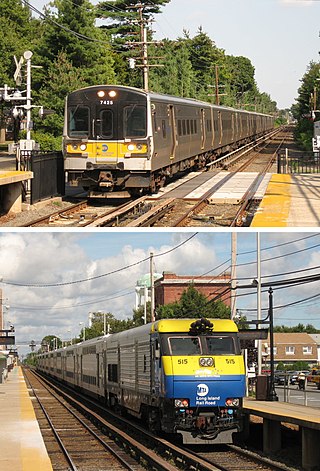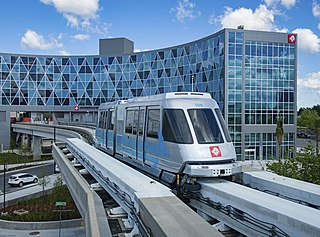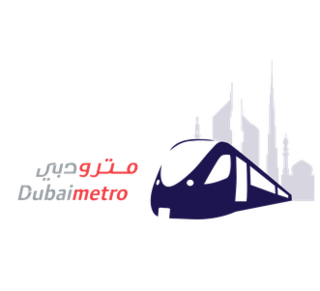
The Long Island Rail Road, often abbreviated as the LIRR, is a railroad in the southeastern part of the U.S. state of New York, stretching from Manhattan to the eastern tip of Suffolk County on Long Island. The railroad currently operates a public commuter rail service, with its freight operations contracted to the New York and Atlantic Railway. With an average weekday ridership of 354,800 passengers in 2016, it is the busiest commuter railroad in North America. It is also one of the world's few commuter systems that runs 24/7 year-round. It is publicly owned by the Metropolitan Transportation Authority, which refers to it as MTA Long Island Rail Road. In 2022, the system had a ridership of 70,342,700, or about 253,800 per weekday as of the third quarter of 2023.

A people mover or automated people mover (APM) is a type of small scale automated guideway transit system. The term is generally used only to describe systems serving relatively small areas such as airports, downtown districts or theme parks.

The Jacksonville Skyway is an automated people mover in Jacksonville, Florida. It opened in 1989 and is operated by the Jacksonville Transportation Authority (JTA). The skyway has three stations in Downtown Jacksonville and was extended in 1996 following a conversion from its original technology to Bombardier Transportation equipment. It was expanded again in 1998 and 2000. The currently fare-free system comprises two routes across 2.5 miles (4.0 km) of track, serving eight stations, and crosses the St. Johns River on the Acosta Bridge. In 2022, the system had a ridership of 276,600, or about 1,400 per day as of the third quarter of 2023.

An elevated railway or elevated train is a railway with the tracks above street level on a viaduct or other elevated structure. The railway may be broad-gauge, standard-gauge or narrow-gauge railway, light rail, monorail, or a suspension railway. Elevated railways are normally found in urban areas where there would otherwise be multiple level crossings. Usually, the tracks of elevated railways that run on steel viaducts can be seen from street level.
Automatic train operation (ATO) is a method of operating trains automatically where the driver is not required or required for supervision at most. Alternatively, ATO can be defined as a subsystem within the automatic train control, which performs any or all of functions like programmed stopping, speed adjusting, door operation, and similar otherwise assigned to the train operator.

The Terminal Link is an automated people mover (APM) at Toronto Pearson International Airport in Mississauga, Ontario, Canada. The wheelchair-accessible train runs 24 hours a day, seven days a week and is completely free-of-charge to ride. In 2012, it transported 17,000 passengers daily, 60 to 70% of whom were airport staff.

The Dubai Metro is a rapid transit rail network in the city of Dubai, United Arab Emirates. It is currently operated by a consortium of the French company, Keolis, and Japanese Company, MHI, as Keolis-MHI.
An airport rail link is a service providing passenger rail transport from an airport to a nearby city by mainline or commuter trains, rapid transit, people mover, or light rail. Direct links operate straight to the airport terminal, while other systems require an intermediate use of people mover or shuttle bus.

Platform screen doors (PSDs), also known as platform edge doors (PEDs), are used at some train, rapid transit and people mover stations to separate the platform from train tracks, as well as on some bus rapid transit, tram and light rail systems. Primarily used for passenger safety, they are a relatively new addition to many metro systems around the world, some having been retrofitted to established systems. They are widely used in newer Asian and European metro systems, and Latin American bus rapid transit systems.

Line 4 is one of the sixteen lines of the Paris Métro rapid transit system and one of its three fully automated lines. Situated mostly within the boundaries of the City of Paris, it connects Porte de Clignancourt in the north and Bagneux-Lucie Aubrac in the south, travelling across the heart of the city. Until its southern terminus was changed from Porte d'Orléans to Mairie de Montrouge in 2013, the line was sometimes referred to as the Clignancourt – Orléans Line. At 13.9 km (8.6 mi) in length, it connects with all Paris Métro lines apart from the very short 3bis and 7bis branch lines, as well as with all 5 RER express lines. It also serves three of the Paris Railway stations, Gare du Nord, Gare de l'Est, and Gare Montparnasse. It is the second-busiest Métro line after Line 1, carrying over 154 million passengers in 2004.

CRRC Zhuzhou Locomotive Co., Ltd. is one of the electric locomotive manufacturers in China. It is one of the subsidiaries of CRRC.

The Taipei Metro VAL 256 is the first generation of automated guideway transit rolling stock to be used on the Wenhu (Brown) line of Taipei Metro.

The Hitachi Rail Italy Driverless Metro is a class of driverless electric multiple units and corresponding signaling system. Manufactured by Hitachi Rail Italy and Hitachi Rail STS in Italy, it is or will be used on the Copenhagen Metro, Princess Nora bint Abdul Rahman University, the Brescia Metro, the Thessaloniki Metro, Line 5 and Line 4 of the Milan Metro, Line C of the Rome Metro, the Honolulu Skyline system, and the Yellow Line of the Taipei Metro. The first system to use this class of driverless electric multiple units was the Copenhagen Metro which was opened in 2002.

Line 5 is an underground rapid transit line in Milan, Italy, part of the Milan Metro. The line, also known as M5 or the Lilac Line, is 12.8-kilometre (8.0 mi) long and goes through the city from the north to the north-west. It opened in stages between 2013 and 2015.

The Delhi Metro is a mass rapid transit (MRT) system which serves Delhi and its adjoining satellite cities, such as Ghaziabad, Faridabad, Gurugram, Noida and Bahadurgarh, in the National Capital Region of India. The system consists of 10 colour-coded lines serving 256 stations, with a total length of 350.42 kilometres (217.74 mi). It is India's largest and busiest metro rail system and the second-oldest, after the Kolkata Metro. The metro has a mix of underground, at-grade, and elevated stations using broad-gauge and standard-gauge tracks. The metro makes over 4,300 trips daily.

The Alstom Metropolis C830C is the second generation of communication-based train control (CBTC) electric multiple unit rolling stock in operation on the Circle line of Singapore's Mass Rapid Transit (MRT) system. 24 trainsets of 3 cars were manufactured by Shanghai Alstom Transport Co Ltd, with deliveries from end June 2014.

The 9000 Series is a series of heavy rail rolling stock that operates on lines 2, 4, 9 and 10 of the Barcelona Metro. Transports Metropolitans de Barcelona (TMB) awarded the contract for the construction of the 9000 series to Alstom in 2002. Constructed in Belgium, France and Spain, they are part of the Alstom Metropolis family of underground trains. Today, the 9000 series also operates in Latin America on the Santo Domingo Metro, Panama Metro, Lima Metro, and 18 three-car trains of this model on Line 3 of the Sistema de Tren Eléctrico Urbano.

The Gatwick Airport Shuttle Transit is a 0.75-mile (1.21 km) long elevated automated people mover that links the North and South Terminals at London's Gatwick Airport. The line is ground-side, and besides linking the two terminals also serves to link the North terminal to the airport railway station. Although sometimes colloquially, but erroneously, known as a "monorail", the transit vehicles are carried on rubber tyres running on a concrete track with twin running surfaces and are steered by separate guide rails.

The LAX Automated People Mover is an under construction automated people mover (APM) system around the Los Angeles International Airport (LAX) area. The system will be owned by Los Angeles World Airports (LAWA) and operated by LAX Integrated Express Solutions (LINXS). The system will run for 2.25 miles (3.62 km) and have six stations that connect the LAX Consolidated Rent-A-Car Facility (ConRAC), the Los Angeles Metro Rail system, and the LAX West Intermodal Transportation Facility with the airport's central terminal area (CTA).
















